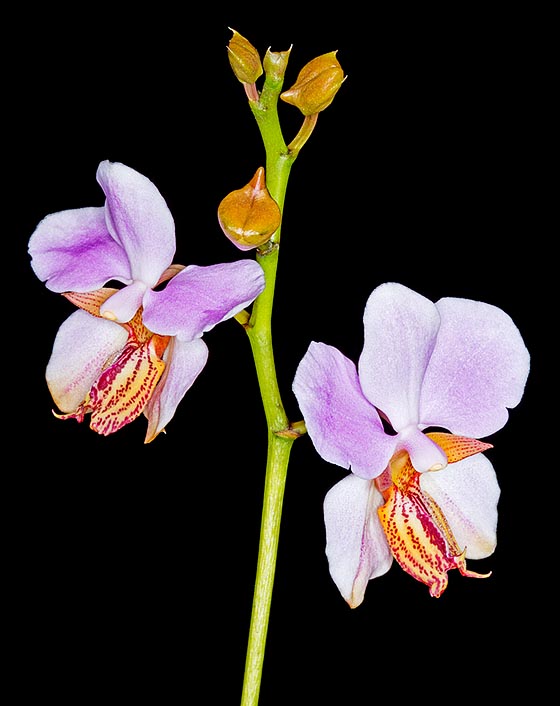Family : Orchidaceae

Text © Pietro Puccio

English translation by Mario Beltramini

Rare species, almost unknown in cultivation, Papilionanthe tricuspidata is endemic to the Lesser Sunda Islands. It has flowers of 6 cm of diameter opening in succession © Giuseppe Mazza
The name of the genus is the combination of the Latin substantive “Papilio, onis” = butterfly and f the Greek “ἄνθος” (anthos) = flower, with obvious reference; the name of the species is the combination of the Latin prefix “tri-” = three and the adjective “cuspidatus, a, um” = cuspidate, pointed, with reference to the labellum furnished of three tips.
The Papilionanthe tricuspidata (J.J.Sm.) Garay (1974) is an epiphytic species with cylindrical ramified stems equipped with long aerial roots and alternate cylindrical leaves, distichous, ascending, 12-15 cm long, with a brusque slight bending near the apex.
Lateral racemose inflorescences opposite to the leaves, 15-30 cm long, bearing some flowers of about 6 cm of diameter, opening in succession, with ovate-elliptic sepals having white suffused of pink rounded apex, almost orbicular petals twisted at the base, of the same colour as the sepals or slightly more intense, trilobed labellum of yellow orange colour dotted of red, with oblong lateral lobes with pointed apex, diverging at the sides of the column, and median lobe with three characteristic tips bent upwards at the apex.
It reproduces by seed, in vitro, and at amateurish level by detaching one ramification, if present, provided of leaves and roots or by dividing the stem in two parts, with each part provided of leaves and roots, the detached part is to be interred in a pot with medium sliced bark, tied to a tutor, and placed, together with the mother plant, in location with high atmospheric humidity and temperature, 24-28 °C; the basal part will produce a new vegetation from a dormant bud.
Rare species and practically unknown in cultivation, with the long-lasting, particularly attractive flowers, needs an exposition in full sun for growing and blooming, high temperatures, 24-32 °C, and humidity, 70-85%, with constant movement of the air. It requires frequent and abundant waterings and nebulisations, to be done in the morning in order to allow the plant to dry up before evening, using rainwater, demineralised or from reverse osmosis. The fertilizations, duly alternated with the waterings in order to avoid salts accumulation at the roots, are to be done with hydro-soluble balanced products, with microelements, at half the dosage suggested by the producer.
Like other Papilionanthe and many Vanda it may be cultivated in suspended baskets without any substratum, in way to allow the roots to freely grow up, or in pots with particularly draining compost that can be formed by bark and pieces of charcoal of 3-4 cm. The roots do not love to be disturbed, therefore transplants and repottings are to be done when strictly necessary, previously moistening the roots in way to render them less frail and more flexible.
The species is reported in the appendix II of the CITES (species whose trade is ruled internationally).
Synonyms: Vanda tricuspidata J.J.Sm. (1913).
→ For general notions about ORCHIDACEAE please click here.
